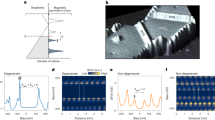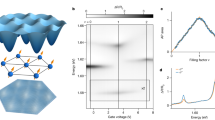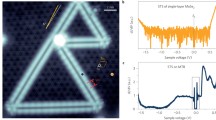Abstract
We consider a quasi-two-dimensional gas of electrons in a typical Si-MOSFET, assuming repulsive contact interaction between electrons. Magnetisation and susceptibility are evaluated within the mean-field approach. Finite thickness of the inversion layer results in an interaction-induced electron wave function change, not found in both purely two-dimensional and three-dimensional (bulk) cases. Taking this self-consistent change into account leads to an increased susceptibility and ultimately to a ferromagnetic transition deep in the high-density metallic regime. We further find that in the paramagnetic state, magnetisation increases sublinearly with increasing in-plane magnetic field. In the opposite limit of low carrier densities, the effects of long-range interaction become important and can be included phenomenologically via bandwidth renormalisation. Our treatment then suggests that with decreasing density, the metal–insulator transition is preceded by a ferromagnetic instability. Results are discussed in the context of the available experimental data, and arguments for the validity of our mean-field scheme are presented.










Similar content being viewed by others
Notes
While any \(U_{ij}\ne 0\) with \(i\ne j\) would also lead to an interaction between same-spin carriers, it obviously cannot give rise to an s-wave repulsion between these. The effects of p-wave and higher harmonics can be expected to be weak and will be neglected.
The role of the \(l=1\) valleys was overlooked in Ref. [30].
Note that this wave functions change is not restricted to electrons in the vicinity of the 2D Fermi surface. This implies that Fermi liquid theory cannot be used to evaluate magnetic susceptibility, and the conventional Fermi-liquid expression for \(\chi \), which can be viewed as an analogue of Eq. (17), is inapplicable in this case.
Here \(n_\downarrow =0\), and we need to redefine \(z_\downarrow \) as \(z_\downarrow =\int \psi _{0,\downarrow }^2(z)z dz \) [cf Eq.(13)].
Values of \(U_{2D}^{l,a;l',a'}\), needed to evaluate \(\chi _0\) in the region \(n_{FM}< n < n_0\), are obtained by finding the \(M=0\) (spin-degenerate) solution to the mean-field equations, even as this solution does not minimise the thermodynamic potential, Eq. (15).
Note that our H is defined in the units of Bohr magnetone.
At these low fields, omitting the orbital effects is mathematically justified.
Here, the scattering length is defined using the reduced mass of a pair of identical particles, i.e. in this case, \(m_*/2\).
Which is expected to provide a valid estimate throughout our range of values of parameters, see ”Appendix”.
In principle, a similar wave function change should occur in various geometrically restricted systems, including quantum dots where it would lead to a magnetisation dependence of electron interaction energies (including exchange). While this would be relevant for the studies of magnetic properties of quantum dots (cf. Ref. [50, 51]), the effect might prove negligible owing to the large quantisation energies.
For a recent mathematical discussion, see Ref. [55].
References
A.B. Fowler, F.F. Fang, W.E. Howard, P.J. Stiles, Phys. Rev. Lett. 16, 901 (1966)
T. Ando, A.B. Fowler, F. Stern, Rev. Mod. Phys. 54, 437 (1982)
S.V. Kravchenko, G.V. Kravchenko, J.E. Furneaux, V.M. Pudalov, M. D’Iorio, Phys. Rev. B 50, 8039 (1994)
S.V. Kravchenko, M.P. Sarachik, Rep. Prog. Phys. 67, 1 (2004), and references therein
B. Spivak, S.V. Kravchenko, S.A. Kivelson, X.P.A. Gao, Rev. Mod. Phys. 82, 1743 (2010), and references therein
I. Shlimak, A. Butenko, D.I. Golosov, K.-J. Friedland, S.V. Kravchenko, Europhys. Lett. 97, 37002 (2012)
D.I. Golosov, I. Shlimak, A. Butenko, K.-J. Friedland, S.V. Kravchenko, Phys. Rev. B 88, 155313 (2013)
S.V. Kravchenko, A.A. Shashkin, S. Anissimova, A. Venkatesan, M.R. Sakr, V.T. Dolgopolov, T.M. Klapwijk, Ann. Phys. 321, 1588 (2006)
A.A. Shashkin, S. Anissimova, M.R. Sakr, S.V. Kravchenko, V.T. Dolgopolov, T.M. Klapwijk, Phys. Rev. Lett. 96, 036403 (2006)
V.M. Pudalov, AYu. Kuntsevich, I.S. Burmistrov, M. Reznikov, J. Low Temp. Phys. 181, 99 (2015), and references therein
O. Prus, Y. Yaish, M. Reznikov, U. Sivan, V. Pudalov, Phys. Rev. B 67, 205407 (2003)
N. Teneh, AYu. Kuntsevich, V.M. Pudalov, M. Reznikov, Phys. Rev. Lett. 109, 226403 (2012)
A. Punnoose, A.M. Finkelstein, Science 310, 289 (2005)
B. Tanatar, D.M. Ceperley, Phys. Rev. B 39, 5005 (1989)
C. Attaccalite, S. Moroni, P. Gori-Giorgi, G.B. Bachelet, Phys. Rev. Lett. 88, 256601 (2002)
M. Marchi, S. De Palo, S. Moroni, G. Senatore, Phys. Rev. B 80, 035103 (2009)
Y. Zhang, S. Das Sarma, Phys. Rev. B 72, 075308 (2005)
Y. Zhang, S. Das Sarma, Phys. Rev. B 72, 115317 (2005)
S. De Palo, M. Botti, S. Moroni, G. Senatore, Phys. Rev. Lett. 94, 226405 (2005)
R. Asgari, B. Tanatar, Phys. Rev. B 74, 075301 (2006)
E. Tutuc, S. Melinte, E.P. De Poortere, M. Shayegan, R. Winkler, Phys. Rev. B 67, 241309 (2003)
V.T. Dolgopolov, JETP Lett. 101, 282 (2015). [Zh. Eksp. Teor. Fiz. Pis’ma Red. 101, 300 (2015)]
T. Dombre, Helv. Phys. Acta 63, 261 (1990)
W. von der Linden, D.M. Edwards, J. Phys. Condens. Matter 3, 4917 (1991)
P. Würth, G. Uhrig, E. Müller-Hartmann, Ann. Phys. 5, 148 (1996)
R. Hlubina, Phys. Rev. 59, 9600 (1999)
F. Becca, S. Sorella, Phys. Rev. Lett. 86, 3396 (2001), and references therein
G.J. Conduit, Phys. Rev. B 87, 184414 (2013), and references therein
V.L. Campo Jr., M. Cococcioni, J. Phys. Condens. Matter 22, 055602 (2010)
D.I. Golosov, J. Magn. Magn. Mater. 400, 93 (2016)
F. Stern, Phys. Rev. B 5, 4891 (1972)
S.D. Sarma, E.H. Hwang, Phys. Rev. Lett. 84, 5596 (2000)
V.T. Renard, B.A. Piot, X. Waintal, G. Fleury, D. Cooper, Y. Niida, D. Tregurtha, A. Fujiwara, Y. Hirayama, K. Takashina, Nat. Commun. 6, 7230 (2015), and references therein
F. Stern, J. Comput. Phys. 6, 56 (1970)
F.F. Fang, W.E. Howard, Phys. Rev. Lett. 16, 797 (1966)
V.T. Dolgopolov, JETP Lett. 76, 377 (2002). [Zh. Eksp. Teor. Fiz. Pis’ma Red. 76, 437 (2015)]
V. Dobrosavljevic, in Conductor Insulator Quantum Phase Transitions, ed. by V. Dobrosavljevic, N. Trivedi, J.M. Valles Jr. (Oxford University Press, Oxford, 2012), and references therein
I.V. Kukushkin, S. Schmult, JETP Lett 101, 693 (2015) [Zh. Eksp. Teor. Fiz. Pis’ma Red., 101, 770 (2015)]
A.Y. Kuntsevich, Y.V. Tupikov, V.M. Pudalov, I.S. Burmistrov, Nat. Commun. 6, 7298 (2015)
A.A. Shashkin, S.V. Kravchenko, V.T. Dolgopolov, T.M. Klapwijk, Phys. Rev. Lett. 87, 086801 (2001)
S.A. Vitkalov, H. Zheng, K.M. Mertes, M.P. Sarachik, T.M. Klapwijk, Phys. Rev. Lett. 87, 086401 (2001)
A.A. Shashkin, S.V. Kravchenko, V.T. Dolgopolov, T.M. Klapwijk, Phys. Rev. B 66, 073303 (2002)
Y. Zhang, S. Das Sarma, Phys. Rev. Lett. 96, 196602 (2006)
A.L. Subasi, B. Tanatar, Phys. Rev. B 78, 155304 (2008)
L.D. Landau, E.M. Lifhitz, Quantum Mechanics. Non-relativistic Theory (Course of Theoretical Physics, Vol. 3) (Pergamon Press, Oxford, 1965)
B.J. Verhaar, J.P.H.W. van der Eijnde, M.A.J. Voermans, M.M.J. Schaffrath, J. Phys. A 17, 595 (1984)
J.R. Engelbrecht, M. Randeria, Phys. Rev. B 45, 12419 (1992)
J.R. Engelbrecht, M. Randeria, L. Zhang, Phys. Rev. B 45, 10135 (1992)
P. Bloom, Phys. Rev. B 12, 125 (1972)
I.L. Kurland, I.L. Aleiner, B.L. Altshuler, Phys. Rev. B 62, 14886 (2000)
A.U. Sharafutdinov, D.S. Lyubshin, I.S. Burmistrov, Phys. Rev. B 90, 195308 (2014)
I.M. Lifshits, Usp. Mat. Nauk 7(1), 171 (1952). (in Russian)
I.M. Lifshits, S.A. Gredeskul, L.A. Pastur, Introduction to the Theory of Disordered Systems (Chapt. 5) (Wiley, New York, 1988)
M.G. Krein, Topics in Differential Equations and Operator Theory (Birkhäuser, Basel, 1983), pp. 107–172
M. Kohmoto, T. Koma, S. Nakamura, Ann. Henri Poincaré 14, 1413 (2013)
I.M. Lifshits, Uchenye Zapiski Kharkovskogo Gos. Universiteta 27, 105 (1948). (in Russian)
Acknowledgements
The author takes pleasure in thanking R. Berkovits, P. Coleman, B. D. Laikhtman, S. V. Kravchenko, I. Shlimak, L. D. Shvartsman, and R. Valenti for enlightening discussions. Discussions with the late K. A. Kikoin are gratefully acknowledged. This work was supported by the Israeli Absorption Ministry.
Author information
Authors and Affiliations
Corresponding author
Appendix: On the Applicability of Stoner-Type Mean-Field Approach in Low-Density 2D Systems
Appendix: On the Applicability of Stoner-Type Mean-Field Approach in Low-Density 2D Systems
In this work, we consider low-density (quasi-)2D electrons, and one might ask whether the short-range repulsion can affect the properties of the system in our range of values of parameters. If the answer were in the negative, this would have turned our mean-field treatment into an artefact of an inadequate approach. It is therefore important to consider this issue in more detail (in addition to discussing the scattering length in Sect. 7).
For simplicity, we consider a purely 2D system,
where the summations are over the particle numbers. The effective 2D interaction \(U_{2D}\) is in our case given by Eq. (10); calculations of Sect. 3 (cf. Fig. 2) yield the value of \(U_{2D}\approx 1.2 \times 10^{-27}\,\hbox {erg} \times \hbox {cm}^{2}\) at \(n = 8 \times 10^{10}\,\hbox {cm}^{-2}\) and \(U_{2D}\approx 5.3 \times 10^{-27}\,\hbox {erg} \times \hbox {cm}^{2}\) at \(n=8 \times 10^{13}\,\hbox {cm}^{-2}\). The level indices are suppressed as presently we are considering the single-level case. Now let us consider interaction of a sole spin-down electron with the spin-up Fermi sea. The mean-field result for the net interaction energy is of course \(\delta E_{mf}=U_{2D} n_\uparrow \) (where at \(M=0\), \(n_\uparrow =n/2\)), and our worry is that this expression may be a gross overestimate. Indeed, with increasing \(U_{2D}\) spin-up electrons will be avoiding the site occupied by the spin-down electron, resulting in a smaller energy change which retains a finite value \(\delta E_{\infty }\) (of the order of the Fermi energy or less) even as \(U_{2D}\) increases to infinity. The situation may arise where actually
in which case we suspect that the mean-field estimates become irrelevant. Note that in reality there is a finite concentration of spin-down particles and the perturbations of spin-up Fermi sea by individual spin-down electrons are not independent, so that \(n_\downarrow \delta E_{\infty }\) underestimates the interaction energy at large \(U_{2D}\). In order to estimate \(\delta E_{\infty }\), we first evaluate the energy change \(\varDelta E\) of a spinless two-valley ideal 2D Fermi gas (\({{\mathcal {H}}}_0=\mathbf {p}^2/2m_\bot \)) under the perturbing effect of a static impurity at origin [corresponding to potential energy \({{\mathcal {V}}}=V\delta (\mathbf {r})\)]. Using the Lifshits–Krein trace formula [52,53,54], this is conveniently expressed as an integral from the bottom of the band to the Fermi energy,
Here, the prefactor corresponds to the two independent valleys, and the spectral shift function \(\xi \) [with the property that \(-d \xi /d \epsilon \) equals \(\delta \nu (\epsilon )\), an impurity-induced correction to the density of states \(\nu (\epsilon )\)] is given by [52,53,54]

Here, the momentum integral is over the Brilloin zone, whereas the energy integral in the last line is over the entire band, \(0< \epsilon ' < W\).
Since we will ultimately need to integrate \(\xi \), the weak singularity at \(\epsilon =0\) is unimportant. In the low-density case of \(\epsilon _F \ll W\) we estimate

with \(\nu _0\) given by Eq. (12), and \(N_0 \sim 1/a^2\) (where a is the lattice period), the full capacity of the 2D band for fixed spin and valley indices. Thus, we find
Spectral shift function is relatedFootnote 14 by the Friedel sum rule to the scatterring phase shift [56], with the Born approximation corresponding to omitting the logarithmic term in Eq. (47). At small V, Eq. (45) then yields the expected perturbative result \(\varDelta E = V n_\uparrow \), whereas for large \(V \mathop {\sim }\limits ^{>} 1/|\nu _0 \log (n_\uparrow a^2/2)|\) we find
The latter is the energy change of spin-up Fermi sea when a node at \(\mathbf {r}=0\) is created in all the electron wave functions. It is seen that indeed at very low densities \(\varDelta E(\infty )/\epsilon _F\) vanishes logarithmically, which is the physical reason why the short-range interaction becomes irrelevant at sufficiently low densities. In our case, however, the absolute value of the log does not exceed 10.
In addition, note that the quantity \(\delta E_\infty \) involves interaction with a spin-down electron which is not localised at origin but is moving with a velocity of order of \(v_F\). The wave functions node is presumably a heavy object, and moving it along would result in a large addition to \(\varDelta E(\infty )\). It is thus more economical to have the spin-down electron localised in an area of size \(R \sim \hbar /p_F\) (which can be done without appreciably changing its energy) while requiring that the wave functions of the spin-up electrons vanish throughout this area. The corresponding energy change of the spin-up Fermi sea is a sum of \(\varDelta E(\infty )\) and an area term, needed to “inflate” the node to the required finite area:
Throughout our range of parameter values, the second term is at least several times smaller than the first one, hence we do not need a more elaborate estimate of the energy of correlated motion of spin-down electron. We are now in a position to quantitatively verify that we never approach the “dangerous” regime specified by the inequality (44). Since presently we did not take into account the possibility of multiple occupied subbands (which is not expected to qualitatively affect the results), this must be done with the help of the numerical results obtained for the single-level case, Sect. 3.
Using the values of \(U_{2D}\) quoted above, we find that at \(n =8 \times 10^{10}\,\hbox {cm}^{-2}\) (where the Fermi energy as measured form the bottom of the band is \(\epsilon _F \equiv E_v-E_0\approx 0.51\) meV), the value of \(\delta E_{mf} \approx 0.029\) meV is about 5 times smaller than \(\delta E_\infty \approx 0.15\) meV. Likewise, at \(n=8 \times 10^{13}\,\)cm\(^{-2}\) (where \(\epsilon _F \approx 0.51\) eV), the value of \(\delta E_{mf} \approx 132\) meV is smaller than \(\delta E_\infty \approx 400\) meV.
We thus conclude that the mean-field estimate of the interaction energy, and by extension the Stoner approach, should be at least qualitatively applicable throughout the entire range of densities considered herein. Since a Stoner-type treatment is anyhow not expected to be quantitatively accurate, this is a satisfactory outcome.
One further note should be made concerning the situation at very low densities near MIT (Sect. 4). In this case, the long-range forces lead to a significant reduction of effective band width (and hence of the effective Fermi energy), to the extent that if those renormalised quantities are substituted when calculating \(\delta E_\infty \), one might find that the inequality (44) is actually satisfied. We wish to argue that such a substitution would be hard to justify, quoting the following reasons:
(1) the renormalised quantities refer not to the electrons, but to the resultant quasiparticles. These are extended objects, which presumably should be viewed as residing on an effective lattice with proportionally increased lattice period, which should thus be used in place of a in Eq. (49).
(2) More importantly, these quasiparticles characterise low-energy, long-wavelength properties of the system, whereas contact interaction with point defects involves a significant short-wavelength component. The short-wavelength contribution to Eq. (45) originates from the logarithmic term in Eq. (47). Therefore, it is more appropriate to use unrenormalised spectral parameters when estimating this term only, including the coefficient before the logarithm. Elsewhere in Eqs. (45) and (47), one should be using the renormalised spectrum characterised by a larger mass, yet it is easy to see that within this order-of-magnitude estimate the renormalisation coefficient cancels out for large V. Hence \(\delta E(\infty )\) retains (roughly) its unrenormalised value and we arrive at a conclusion that the mean-field approach is still qualitatively applicable.
Rights and permissions
About this article
Cite this article
Golosov, D.I. Stoner-Type Theory of Magnetism in Silicon MOSFETs. J Low Temp Phys 188, 67–100 (2017). https://doi.org/10.1007/s10909-017-1781-3
Received:
Accepted:
Published:
Issue Date:
DOI: https://doi.org/10.1007/s10909-017-1781-3




